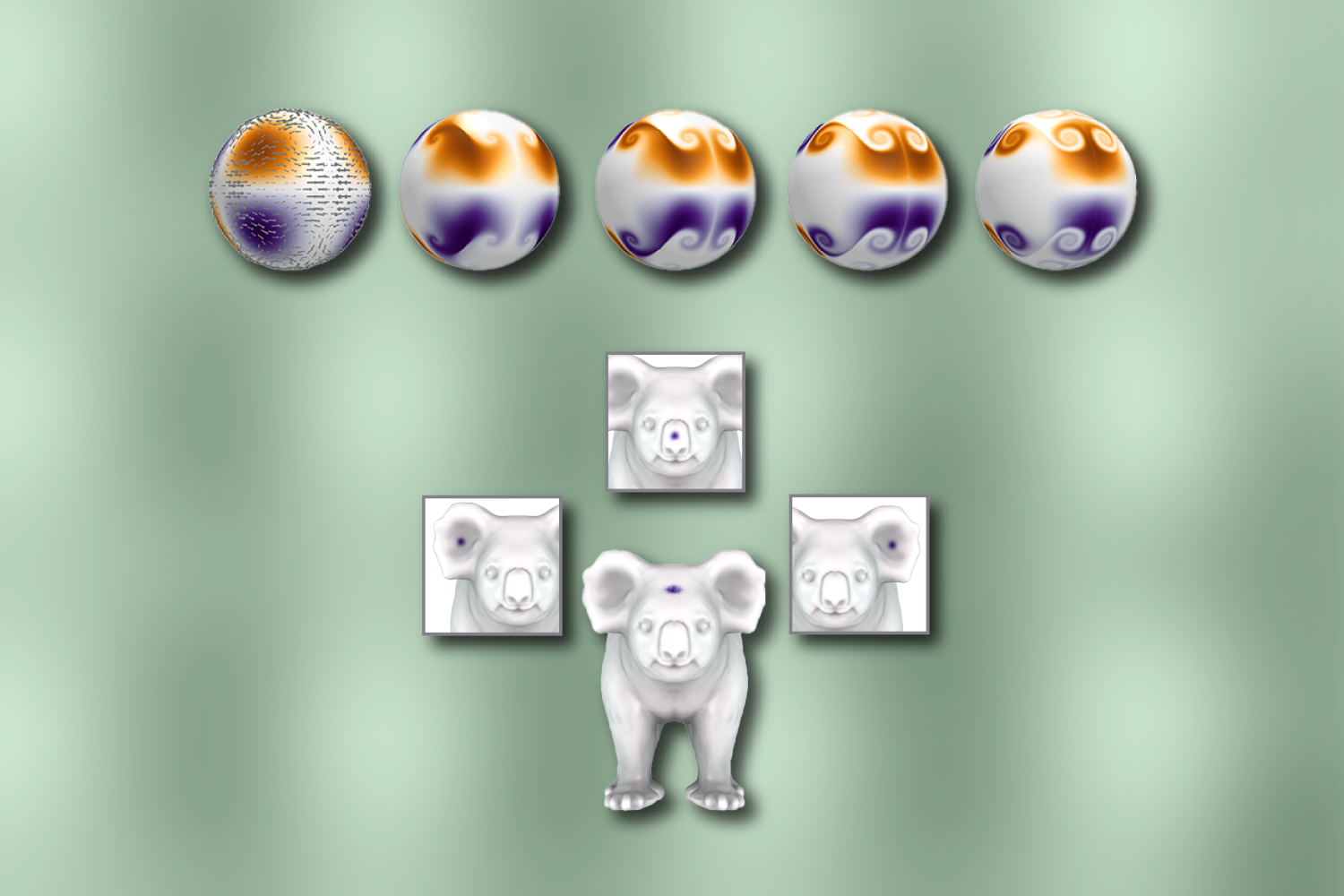[ad_1]

Pc graphics and geometry processing analysis present the instruments wanted to simulate bodily phenomena like hearth and flames, aiding the creation of visible results in video video games and films in addition to the fabrication of advanced geometric shapes utilizing instruments like 3D printing.
Beneath the hood, mathematical issues known as partial differential equations (PDEs) mannequin these pure processes. Among the many many PDEs utilized in physics and laptop graphics, a category known as second-order parabolic PDEs clarify how phenomena can turn into easy over time. Essentially the most well-known instance on this class is the warmth equation, which predicts how warmth diffuses alongside a floor or in a quantity over time.
Researchers in geometry processing have designed quite a few algorithms to unravel these issues on curved surfaces, however their strategies usually apply solely to linear issues or to a single PDE. A extra common method by researchers from MIT’s Pc Science and Synthetic Intelligence Laboratory (CSAIL) tackles a common class of those doubtlessly nonlinear issues.
In a paper just lately printed within the Transactions on Graphics journal and introduced on the SIGGRAPH convention, they describe an algorithm that solves totally different nonlinear parabolic PDEs on triangle meshes by splitting them into three easier equations that may be solved with methods graphics researchers have already got of their software program toolkit. This framework may also help higher analyze shapes and mannequin advanced dynamical processes.
“We offer a recipe: If you wish to numerically clear up a second-order parabolic PDE, you’ll be able to comply with a set of three steps,” says lead writer Leticia Mattos Da Silva SM ’23, an MIT PhD pupil in electrical engineering and laptop science (EECS) and CSAIL affiliate. “For every of the steps on this method, you’re fixing an easier downside utilizing easier instruments from geometry processing, however on the finish, you get an answer to the more difficult second-order parabolic PDE.”
To perform this, Da Silva and her coauthors used Strang splitting, a way that enables geometry processing researchers to interrupt the PDE down into issues they know learn how to clear up effectively.
First, their algorithm advances an answer ahead in time by fixing the warmth equation (additionally known as the “diffusion equation”), which fashions how warmth from a source spreads over a form. Image utilizing a blow torch to heat up a steel plate — this equation describes how warmth from that spot would diffuse over it. This step might be accomplished simply with linear algebra.
Now, think about that the parabolic PDE has further nonlinear behaviors that aren’t described by the unfold of warmth. That is the place the second step of the algorithm is available in: it accounts for the nonlinear piece by fixing a Hamilton-Jacobi (HJ) equation, a first-order nonlinear PDE.
Whereas generic HJ equations might be arduous to unravel, Mattos Da Silva and coauthors show that their splitting technique utilized to many essential PDEs yields an HJ equation that may be solved by way of convex optimization algorithms. Convex optimization is a normal instrument for which researchers in geometry processing have already got environment friendly and dependable software program. Within the remaining step, the algorithm advances an answer ahead in time utilizing the warmth equation once more to advance the extra advanced second-order parabolic PDE ahead in time.
Amongst different functions, the framework might assist simulate hearth and flames extra effectively. “There’s an enormous pipeline that creates a video with flames being simulated, however on the coronary heart of it’s a PDE solver,” says Mattos Da Silva. For these pipelines, a vital step is fixing the G-equation, a nonlinear parabolic PDE that fashions the entrance propagation of the flame and might be solved utilizing the researchers’ framework.
The group’s algorithm also can clear up the diffusion equation within the logarithmic area, the place it turns into nonlinear. Senior writer Justin Solomon, affiliate professor of EECS and chief of the CSAIL Geometric Information Processing Group, beforehand developed a state-of-the-art approach for optimum transport that requires taking the logarithm of the results of warmth diffusion. Mattos Da Silva’s framework offered extra dependable computations by doing diffusion immediately within the logarithmic area. This enabled a extra steady option to, for instance, discover a geometric notion of common amongst distributions on floor meshes like a mannequin of a koala.
Though their framework focuses on common, nonlinear issues, it can be used to unravel linear PDE. As an illustration, the strategy solves the Fokker-Planck equation, the place warmth diffuses in a linear method, however there are further phrases that drift in the identical path warmth is spreading. In a simple utility, the method modeled how swirls would evolve over the floor of a triangulated sphere. The consequence resembles purple-and-brown latte artwork.
The researchers notice that this mission is a place to begin for tackling the nonlinearity in different PDEs that seem in graphics and geometry processing head-on. For instance, they targeted on static surfaces however wish to apply their work to shifting ones, too. Furthermore, their framework solves issues involving a single parabolic PDE, however the group would additionally prefer to deal with issues involving coupled parabolic PDE. These kinds of issues come up in biology and chemistry, the place the equation describing the evolution of every agent in a mix, for instance, is linked to the others’ equations.
Mattos Da Silva and Solomon wrote the paper with Oded Stein, assistant professor on the College of Southern California’s Viterbi Faculty of Engineering. Their work was supported, partly, by an MIT Schwarzman Faculty of Computing Fellowship funded by Google, a MathWorks Fellowship, the Swiss Nationwide Science Basis, the U.S. Military Analysis Workplace, the U.S. Air Power Workplace of Scientific Analysis, the U.S. Nationwide Science Basis, MIT-IBM Watson AI Lab, the Toyota-CSAIL Joint Analysis Middle, Adobe Programs, and Google Analysis.
[ad_2]
Alex Shipps | MIT CSAIL
2024-08-28 20:30:00
Source hyperlink:https://information.mit.edu/2024/framework-solving-parabolic-partial-differential-equations-0828

